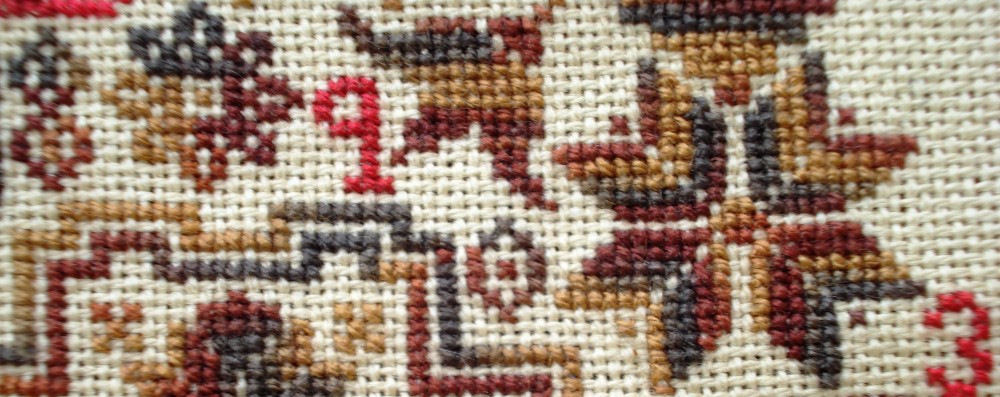I have to wonder if I have ESP. Last week when I posted about French Knots, I mentioned I much prefer the Bullion Knot or Bullion Stitch. And what do we have for this week’s TAST Challenge?! Yup…The Bullion Stitch. I decided to make a spray of wisteria on my Sampler. The Bullion Knot is perfect for such drapey flowers. I’d be interested to hear from you what other flowers this stitch would be good for.

Yet another Spring Swag…this one with Bullion Stitch, Stem Stitch, and Chain with Bullion Stitch tip
It was interesting to look at the different tutorials available for this stitch. Using my own Stitch Diagram reference page, I found Sarah’s tutorial to be most useful to me. I really needed a refresher, too! The last time I did bullion stitches was in (about) 1996 when I was determined to learn ribbon embroidery while I recuperated from surgery.
Sharon’s recommendation to use a needle whose eye outer diameter is the same as the needle shaft to the point is right on. As she says on Pin Tangle:
People either love or hate bullions, but most of the problems associated with working them is that people use the wrong needle.
I recommend milliners or straw needles because most embroidery needles have an eye that is wider than the shaft of the needle. Milliners or straw needles have an eye and shaft that are the same width which makes sliding the wrapped bullion knot along the needle easy. Try it as it does make a difference. (Sharon Boggon)
She’s so right! This is important because not only does the needle have to go through the thread you wrap or coil around the needle, but you also need to drag the doubled thread through the coiled thread, too. I did not have the perfect needles on hand for this, so I tried to compensate by allowing the coils to relax as I wiggled the needle and thread through the coil. I think that may have given me my little problem of the bottom-most coil being a tad loose.
I used three types of thread to work my bullions—a silk ribbon (the green), a rayon loosely woven ribbon (the darker purple on the left), and DMC #5 Perle Cotton (the light purple on the left and all purples on the right.) It was definitely easier making the bullions with the cotton Perle.

The leaf on the right is a fair example of the Chain Stitch with ending done in Bullion Stitch. The Silk on the left leaf was somewhat twisted while wrapping the needle.
There are actually three stitches in my sample. First, I made a “branch” with stem stitch using two plies of cotton floss. Then there are the bullion wisteria flowers that I made with the Perle cotton and the rayon silk. The green leaves are a composite stitch made up of a chain stitch where the anchoring final stitch is completed as a bullion stitch. It gives a nice shape to the leaves, I think. What do you think? Come on Don’t be shy! I can take it!

I think you have made great use of the shape of the stitch for the Wisteria. I guess the most common bullion flower is the Rose. How about Daisy petals, Bulrush and the centre of an Anthurium?
The Wisteria is in bloom in Japan right now, so I adore your entry for TAST Week 20!
I’m not familiar with Bulrush and Anthurium. Will have to look them up! Thank you!
A lovely plant!
I love wisteria, too!